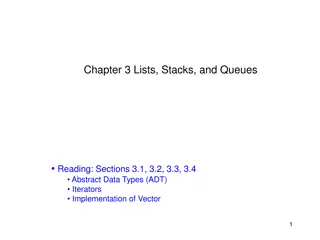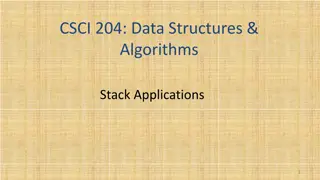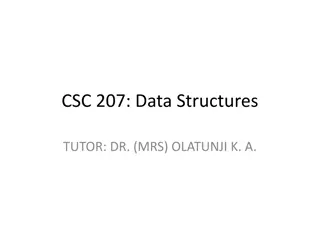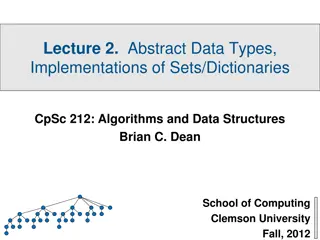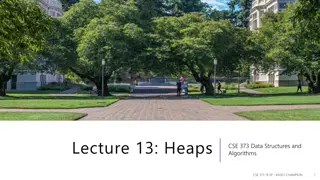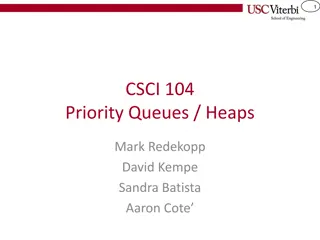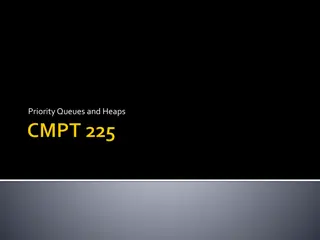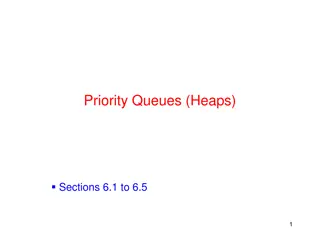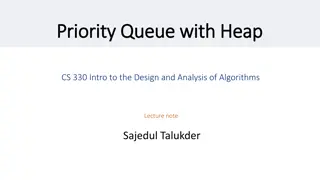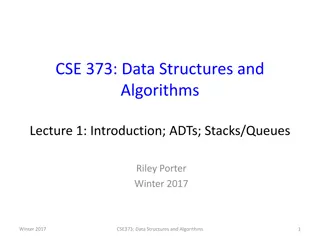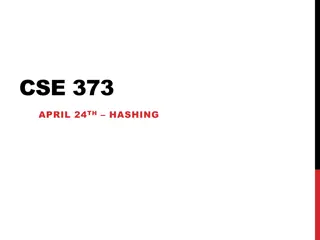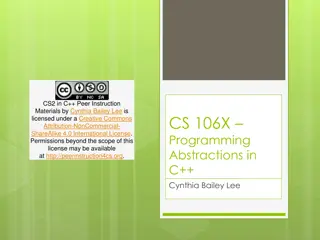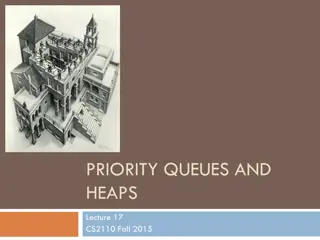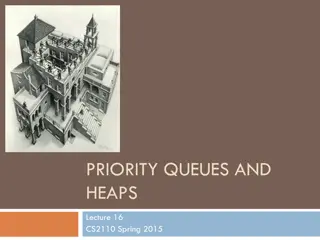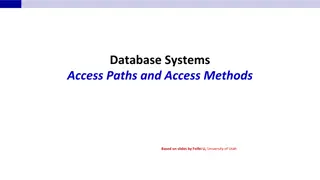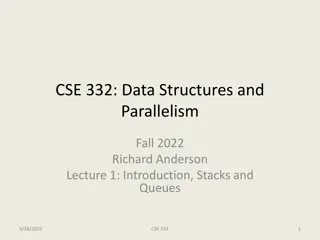
Queues and Stacks in Computer Science
Explore the concepts of queues and stacks in computer science, including their operations, implementations, and applications. Learn how queues and stacks can be specialized to create useful data structures like FIFO queues and LIFO stacks.
Download Presentation

Please find below an Image/Link to download the presentation.
The content on the website is provided AS IS for your information and personal use only. It may not be sold, licensed, or shared on other websites without obtaining consent from the author. If you encounter any issues during the download, it is possible that the publisher has removed the file from their server.
You are allowed to download the files provided on this website for personal or commercial use, subject to the condition that they are used lawfully. All files are the property of their respective owners.
The content on the website is provided AS IS for your information and personal use only. It may not be sold, licensed, or shared on other websites without obtaining consent from the author.
E N D
Presentation Transcript
1 CSCI 104 Queues and Stacks Mark Redekopp David Kempe Sandra Batista Aaron Cote
2 Stacks & Queues Lists are good for storing generic sequences of items, but they can be specialized to form other useful structures What if we had a List, but we restricted how insertion and removal were done? Stack Only ever insert/remove from one end of the list Queue Only ever insert at one end and remove from the other
3 Queue ADT Queue A list of items where insertion only occurs at the back of the list and removal only occurs at the front of the list Like waiting in line for a cashier at a store Queues are FIFO (First In, First Out) Items at the back of the queue are the newest Items at the front of the queue are the oldest Elements are processed in the order they arrive
4 A Queue Visual Items leave from the front (pop_front) Items enter at the back (push_back) (pop_front) (push_back)
5 Queue Operations What member functions does a Queue have? push_back(item) Add an item to the back of the Queue pop_front() - Remove the front item from the Queue front() - Get a reference to the front item of the Queue (don't remove it though!) size() - Number of items in the Queue empty() - Check if the Queue is empty (push_back) (pop_front)
6 A Queue Class A sample class interface for a Queue Queue Error Conditions Queue Underflow The name for the condition where you call pop on an empty Queue Queue Overflow The name for the condition where you call push on a full Queue (a Queue that can't grow any more) This is only possible for Queues that are backed by a bounded list #ifndef QUEUEINT_H #define QUEUEINT_H class QueueInt { public: QueueInt(); ~QueueInt(); size_t size() const; // enqueue void push_back(const int& value); // dequeue void pop_front(); // dequeue int const & front() const; bool empty() const; private: // ??? }; #endif
7 Other Queue Details How should you implement a Queue? Compose using an ArrayList Compose using a singly-linked list w/o a tail pointer Compose using a singly-linked list w/ a tail pointer Which is best? Push_back Pop_front Front() ArrayList LinkedList (Singly-linked w/o tail ptr) LinkedList (Singly-linked w/ tail ptr)
8 Other Queue Details How should you implement a Queue? Compose using an ArrayList Compose using a singly-linked list w/o a tail pointer Compose using a singly-linked list w/ a tail pointer Which is best? Push_back Pop_front Front() ArrayList O(1) O(n) O(1) LinkedList (Singly-linked w/o tail ptr) O(n) O(1) O(1) LinkedList (Singly-linked w/ tail ptr) O(1) O(1) O(1)
9 Queue Applications Print Jobs Click Print on the computer is much faster than actually printing (build a backlog) Each job is processed in the order it's received (FIFO) Why would you want a print queue rather than a print stack Seating customers at a restaurant Anything that involves "waiting in line" Helpful to decouple producers and consumers
10 Stack ADT Stack: A list of items where insertion and removal only occurs at one end of the list Examples: A stack of boxes where you have to move the top one to get to ones farther down A spring-loaded plate dispenser at a buffet A PEZ dispenser Your e-mail inbox Stacks are LIFO Newest item at top Oldest item at bottom (push) (pop) Top item Stack
11 Stack Operations What member functions does a Stack have? push(item) Add an item to the top of the Stack pop() - Remove the top item from the Stack top() - Get a reference to the top item on the Stack (don't remove it though!) size() - Get the number of items in the Stack What member data does a Stack have? A list of items Top/Last Item Pointer/Index (pop) (push) Top/Last Item Top item Stack
12 Stack Axioms For all stacks, s: s.push(item).top() = item s.push(item).pop() = s Let s draw the stack for these operations: s.push(5).push(4).pop().top() (push) (pop) Top item Stack
13 A Stack Class A sample class interface for a Stack How should you implement a Stack? Back it with an array Back it with a linked list Which is best? Stack Error Conditions Stack Underflow The name for the condition where you call pop on an empty Stack Stack Overflow The name for the condition where you call push on a full Stack (a stack that can't grow any more) #ifndef STACKINT_H #define STACKINT_H class StackInt { public: StackInt(); ~StackInt(); size_t size() const; bool empty() const; void push(const int& value); void pop(); int const & top() const; }; #endif
14 Array Based Stack #ifndef STACKINT_H #define STACKINT_H A sample class interface for a Stack If using an array list, which end should you use as the "top"? Front or back? If using a linked list, which end should you use? If you just use a head pointer only? If you have a head and tail pointer? class StackInt { public: StackInt(); ~StackInt(); size_t size() const; bool empty() const; void push(const int& value); void pop(); int const& top() const; private: AListInt mylist_; // or LListInt mylist_; }; #endif
15 Stack Examples #include <iostream> #include <string> #include "stack.h" using namespace std; int main() { StackChar s; Reverse a string string word; cout << "Enter a word: "; getline(cin,word); for(int i=0; i < word.size(); i++) s.push(word.at(i)); while(!s.empty()){ cout << s.top(); s.pop(); } } Type in: "hello" Output: "olleh"
16 Another Stack Example Depth First Search Use a stack whenever you encounter a decision, just pick and push decision onto stack. If you hit a dead end pop off last decision (retrace steps) and keep trying, etc. Assume we always choose S, then L, then R Straight or Left Choose straight dead end Pop straight and make next choice left Next decision is Straight or Right choose Straight http://www.pbs.org/wgbh/nova/einstein/images/lrk-maze.gif
17 Stack Usage Example (7 * [8 + [9/{5-2}]]) ( [ [ Check whether an expression is properly parenthesized with '(', '[', '{', '}', ']', ')' Correct: (7 * [8 + [9/{5-2}]]) Incorrect: (7*8 Incorrect: (7*8] Note: The last parentheses started should be the first one completed Approach Scan character by character of the expression string Each time you hit an open-paren: '(', '[', '{' push it on the stack When you encounter a ')', ']', '}' the top character on the stack should be the matching opening paren type, otherwise ERROR! { } ] ] ) { [ [ ( (7 * [4 + 2 + 3]) 9 3 5 9 3 + 63 2 + 4 9 * [ * 7 7 ( 63 (
18 Queue with two stacks To enqueue(x), push x on stack 1 To dequeue() If stack 2 empty, pop everything from stack 1 and push onto stack 2. Pop stack 2 stack1 stack2 stack1 stack2 stack1 stack2 Time=1 Time=2 Time=3
19 The Deque ADT Double-ended queues Equally good at pushing and popping on either end (push_front) (push_back) (pop_front) (pop_back)
20 STL Deque Class Similar to vector but allows for push_front() and pop_front() options Useful when we want to put things in one end of the list and take them out of the other #include <iostream> #include <deque> using namespace std; int main() { deque<int> my_deq; for(int i=0; i < 5; i++){ my_deq.push_back(i+50); } cout << At index 2 is: << my_deq[2] ; cout << endl; for(int i=0; i < 5; i++){ int x = my_deq.front(); my_deq.push_back(x+10); my_deq.pop_front(); } while( ! my_deq.empty()){ cout << my_deq.front() << ; my_deq.pop_front(); } cout << endl; } 1 0 1 2 3 4 1 2 3 4 my_deq 50 51 52 53 54 2 3 0 1 2 3 4 my_deq 51 52 53 54 60 after 1st iteration 0 1 2 3 4 4 my_deq 60 61 62 63 64 after all iterations my_deq
21 STL Vector vs. Deque std::vector is essentially a Dynamic Array List Slow at removing and inserting at the front or middle Fast at adding/remove from the back Implies it could be used well as a (stack / queue) std::deque gives fast insertion and removal from front and back along with fast random access (i.e. get(i) ) Almost has "look and feel" of linked list with head and tail pointers providing fast addition/removal from either end Implies it could be used well as a (stack / queue) Practically it is likely implemented as a circular array buffer
22 Circular Buffers Take an array but imagine it wrapping into a circle to implement a deque Setup a head and tail pointer Head points at first occupied item, tail at first free location Push_front() and pop_front() update the head pointer Push_back() and pop_back() update the tail pointer To overcome discontinuity from index 0 t;o MAX-1, use modulo operation Cannot just use back++; to move back ptr Instead, use back = (back + 1) % MAX; Get item at index i Must be relative to the front pointer 0 1 2 3 4 5 6 7 5 6 7 4 0 3 1 2 front back 1.) Push_back() 2.) Push_back() 3.) Push_front() front 5 6 5 6 7 4 7 4 0 3 0 3 1 2 1 2 front size=3 back back size=2

